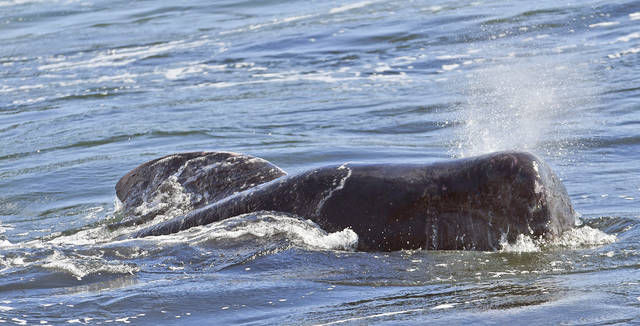LIHUE — The initial investigation into the deaths of five pilot whales at Kalapaki Beach last Friday showed “no obvious cause of death.” According to a Thursday statement from National Oceanic and Atmospheric Administration Fisheries, “At this time, we have
LIHUE — The initial investigation into the deaths of five pilot whales at Kalapaki Beach last Friday showed “no obvious cause of death.”
According to a Thursday statement from National Oceanic and Atmospheric Administration Fisheries, “At this time, we have not yet determined a reason for the stranding.”
The statement also cleared military activities of having a role in the incident.
“The Navy confirmed that there was no mid-frequency active sonar in the area at the time of the stranding. The Navy also confirmed there were no in-water explosives used in the area,” it said.
Several whales beached themselves last Friday morning. Many visitors and locals on the frantic scene teamed up to push the whales back out. Some of the whales, though, continued to return to shore.
The release said mass strandings for pilot whales “are fairly common globally. Since pilot whales are social, when one individual strands, others tend to follow.”
Personnel from the University of Hawaii, NOAA Fisheries, Hawaii State Department of Land and Natural Resources, and volunteers worked together to conduct a necropsy on all five whales to investigate the cause of stranding.
“The preliminary necropsy results showed no obvious cause of death,” the statement said.
Samples were taken and sent out to labs for the study of microscopic structure in tissue analysis.
“Histologic examination of these tissues may provide more insight into the general health of these animals as it may relate to possible infectious pathogens, toxins, trauma, and individual organ function,” the release said.
NOAA worked with cultural practitioners on Kauai for appropriate handling of the whale remains.
Mayor Bernard Carvalho Jr., in a written statement, said responding NOAA staff were very professional and respectful of the Hawaiian culture during their response to the whale beaching incident.
“Agency members, volunteers, first responders, and community members came together to help the whales in what was a very emotional scene,” he said.
“We are grateful that NOAA is keeping the community informed, and we look forward to receiving additional information as it becomes available.”
Gordon LaBedz of Whale Voice said the results of the autopsy were “100 percent predictable.”
“These autopsies generally don’t reveal an obvious cause of death. It does show that those were healthy whales,” he said. “Those were not sick whales that suddenly got a virus, pneumonia, encephalitis or something like that. They were healthy whales. Five healthy whales died, and that means something that humans did caused it. That’s all it could mean.”
LaBedz said he was there and saw the whales in Nawiliwili Stream. He said they were big, strong healthy-looking whales.
“They weren’t entangled, they weren’t hit by a ship, they weren’t emaciated,” he said.
An investigation continues.
UH and DLNR are working to search for the presence of rodenticide — diphacinone was applied at Lehua Island about a month ago — in liver tissue of the whales. Results of those tests will take some time to return, NOAA said.
The statement from NOAA also noted that:
w NOAA Ship Okeanos Explorer was underway off Honolulu on Thursday, Oct. 12, from 10 a.m. to 3 p.m. Hawaii Time to undergo an annual at-sea safety inspection. The ship’s seafloor imaging systems, including its multi-beam echosounder, were not in use during these exercises.
w No other NOAA ships were underway around the Hawaiian Islands between Oct. 10 and Oct. 16. Okeanos Explorer departed Honolulu on Oct. 16 and is en route to Balboa, Panama.


